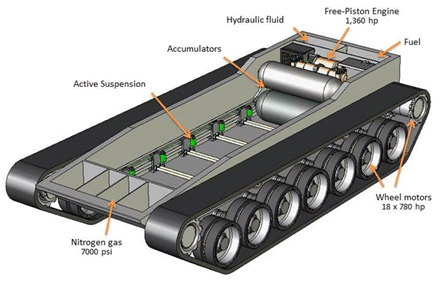| Weight |
45 to |
|
|
| L / W / H |
32‘x11.5‘x7.9‘ |
Hull |
24.3’x7’x3.8’ |
| Drive train |
Power |
Weight |
L / W / H |
| Engine |
1,360 hp |
670 lbs. |
49” x 14” x 28” |
| Motors (18) |
13,700 hp |
2,550 lbs. |
Ø 7.9“ x 12.6" |
| Energy storage |
18 MJ (408 hp·min) |
|
|
| Speed |
62 mph |
|
|
| Operational range |
500 miles |
|
|
The new hydrostatic drivetrain with energy storage increases the performance of the vehicle and the protection for its occupants while significantly reducing the costs of procurement and operation.
The hull of the vehicle contains the very compact free-piston combus-tion engine and the hydraulic section of the accumulators. The energy storing compressed nitrogen gas is located in separate sections of the hull. Multiple walls and the high pressure of the gas (up to 7,000 psi) improve the protection for the occupants. Compared with modern battle tanks, the new powertrain provides significantly more interior space and less thermal stress, while reducing the size and weight of the hull noticeably.

Drivetrain Concept
The high efficiency of the engine and complete recuperation of braking- and damping energy (suspension, cannon) reduce the fuel consump-tion by more than 40%, and the low heat radiation and external motors the required cooling by more than 75%. Furthermore, operating the vehicle with stored energy allows, depending on the field conditions, a driving distance of 0.6 to 2.5 miles and a significant reduction in radiation of noise and heat.
The tracks are driven by engageable and disengageable, continuously variable hydraulic motors with a planetary gear stage in all wheels. (Compared to the previous version, the speed range of the motor has been extended.) The size of the motors and accumulators are sufficient to provide the maximum torque for braking and capacity for storing the recuperated energy. The driving performance is therefore very high and the control through the individually driven wheels very effective. Electro-nically controlled dampening cylinders at the wheels enable an active control of the suspension, leveling, and recuperation of dampening energy. The ability to drive without tracks result in a significant increase in redundancy, operational range, and maximum speed. The reduced forces within the track minimize their weight and maintenance.
Copyright Valentin Technologies, LLC
The pictures show the vehicle with the main drivetrain components in full scale. The engine and motor above describe the components in greater detail.